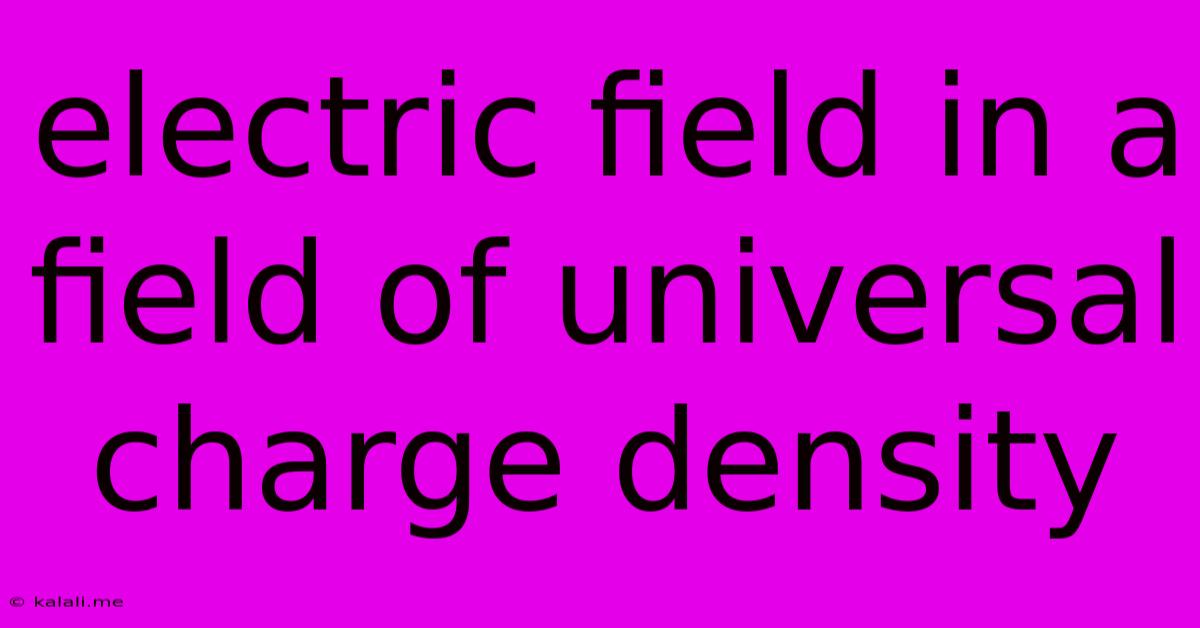Electric Field In A Field Of Universal Charge Density
Kalali
Jun 02, 2025 · 3 min read

Table of Contents
Electric Field in a Universe of Uniform Charge Density
The concept of an electric field permeating a universe with uniform charge density presents a fascinating challenge in electromagnetism. Understanding this scenario requires a careful application of Gauss's law and a consideration of the implications of infinite space. This article will delve into the derivation of the electric field strength and discuss the unique characteristics of this system. We'll explore the implications of this theoretical model and compare it to real-world scenarios.
What is Uniform Charge Density?
Before we dive into the calculations, let's define our terms. Uniform charge density refers to a scenario where the electric charge is distributed evenly throughout space. This means that the volume charge density, denoted by ρ (rho), is constant everywhere in the universe. This is, of course, a highly idealized model, as the universe isn't uniformly charged. However, exploring this model provides valuable insights into fundamental principles of electrostatics. We are considering an infinite, homogenous distribution of charge.
Applying Gauss's Law
Gauss's law is a powerful tool for calculating electric fields, especially in situations with high symmetry. The law states that the flux of the electric field through a closed surface is proportional to the enclosed charge. Mathematically, it's expressed as:
∮ E ⋅ dA = Q<sub>enc</sub> / ε<sub>0</sub>
Where:
- E is the electric field vector
- dA is a vector representing a small area element on the Gaussian surface
- Q<sub>enc</sub> is the total charge enclosed within the Gaussian surface
- ε<sub>0</sub> is the permittivity of free space
Because of the spherical symmetry inherent in a uniformly charged universe, a spherical Gaussian surface is the logical choice. The electric field will be radially outward (or inward, depending on the sign of the charge density) and its magnitude will only depend on the distance from the center of the sphere.
Derivation of the Electric Field
Let's consider a sphere of radius r centered at any arbitrary point. The charge enclosed within this sphere is simply the volume of the sphere multiplied by the charge density:
Q<sub>enc</sub> = ρ * (4/3)πr³
The electric field is radial, so the dot product in Gauss's law simplifies. The surface area of the sphere is 4πr². Therefore, Gauss's law becomes:
E * 4πr² = ρ * (4/3)πr³ / ε<sub>0</sub>
Solving for the electric field strength, E, we obtain:
E = ρr / (3ε<sub>0</sub>)
This equation reveals a crucial characteristic: the electric field strength is directly proportional to the distance from the center of the sphere. This is significantly different from the electric field of a point charge, which decreases with the square of the distance. In this uniformly charged universe, the field strength increases linearly with distance.
Implications and Limitations
The result above demonstrates a fundamental difference when considering a uniformly charged infinite space. The electric field magnitude continuously increases with distance, a stark contrast to the inverse-square law familiar from point charges or finite distributions. This seemingly paradoxical result highlights the limitations of applying this purely theoretical model to the real universe. Real-world charge distributions are far from uniform, and the infinite extent of the model introduces mathematical complexities. This model serves as a useful exercise in understanding the application of Gauss's law and appreciating the subtleties of electrostatics. It prompts us to consider the importance of realistic boundary conditions and charge distributions when tackling problems in electromagnetism.
The infinite nature of the model poses challenges for physical interpretation. The ever-increasing electric field suggests an infinite energy density, which is physically impossible. This underscores the need for more realistic models that reflect the finite extent and non-uniform nature of real-world charge distributions. However, this model provides a valuable stepping stone in our understanding of how charge density impacts the electric field.
Latest Posts
Latest Posts
-
Append To String Variable Replaces Value Power Automate
Jun 04, 2025
-
Portable A C Vent Hose To Wall Port Reducer
Jun 04, 2025
-
Which Is The Parent In A Many To Many Relation
Jun 04, 2025
-
What Transfer Network To Use For Retik To Metamask
Jun 04, 2025
-
How To Make Borderlands 2 Full Screen Mac
Jun 04, 2025
Related Post
Thank you for visiting our website which covers about Electric Field In A Field Of Universal Charge Density . We hope the information provided has been useful to you. Feel free to contact us if you have any questions or need further assistance. See you next time and don't miss to bookmark.